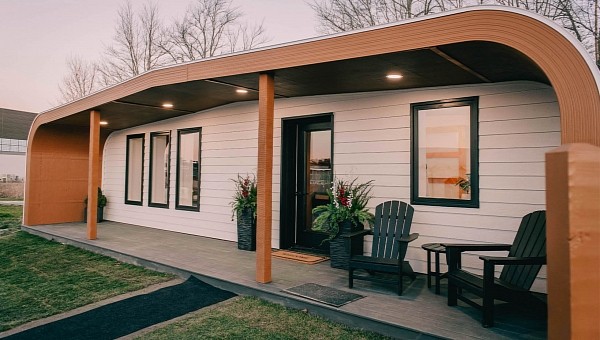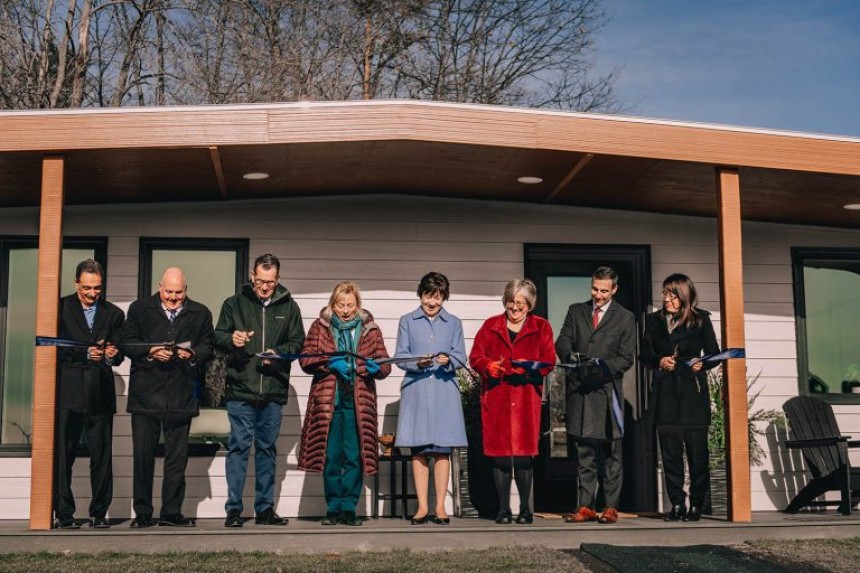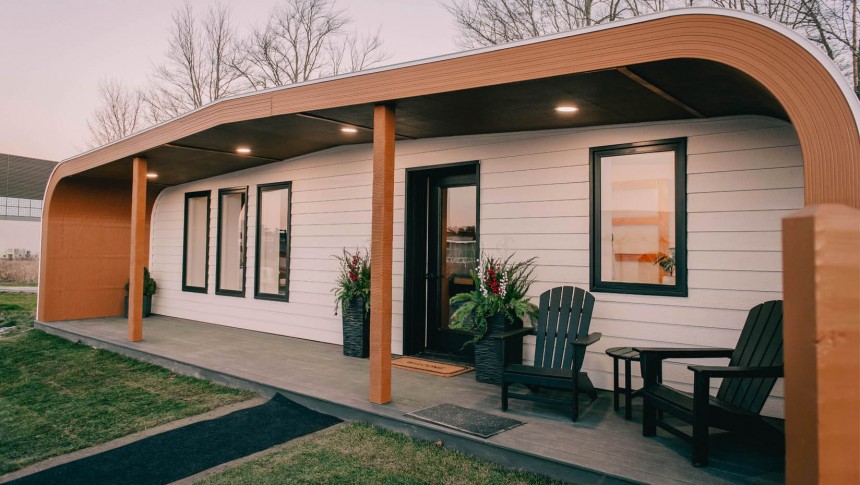Not that any of us needed reminding, but these are hard times we’re living in. The looming financial crisis is only going to worsen the already existing housing crisis and workforce and supply shortage issues. The BioHome3D could be the proverbial light at the end of the tunnel.
3D printing is widely regarded as a viable alternative to traditional house construction, offering benefits like shorter delivery timelines, waste reduction, and higher efficiency. So far, though, 3D-printed houses have still relied on traditional construction materials, the University of Maine says. This one doesn’t, and it could make all the difference in this “perfect storm” that’s coming.
BioHome3D is a 3D-printed house, but one that uses locally resourced materials, which make it a better alternative to cement-based 3D-printed houses. It also makes it fully recyclable at the end of its lifecycle, fully customizable in all aspects so that it fits the future owner’s idea of a perfect home, and easily assembled and rendered livable.
The BioHome3D is also a very real house, though only one such unit exists as of the time of press.
Unveiled to the public on November 21, the BioHome3D is the result of a partnership between the University of Maine Advanced Structures and Composites Center (ASCC), MaineHousing and the Maine Technology Institute, with funding from the Hub and Spoke program from the U.S. Department of Energy. It is designed to address several pressing issues, like the housing crisis, the shortage of supplies and workforce, and the need to deliver an affordable product in the least amount of time.
Instead of using cement or similar materials for the 3D printing process, the Maine 3D printer, which previously set the record for the world’s largest 3D-printed boat, used natural wood fibers and bioresins as feedstock. This means that it’s made entirely from natural and locally sourced materials, including the walls and the floors. By comparison, other 3D-printed homes only have the walls 3D-printed from cement, sit on a cast cement foundation and rely on traditionally built roofs, using traditional roof materials.
The advantage of the BioHome3D is huge over similar houses, the University of Maine says. For one, the home relies on a locally available and very generous resource for the construction: wood. Secondly, the home can be fully customizable, from aesthetics to its final R-values. Thirdly, because it’s built with sustainably grown wood fiber derived from trees that captured carbon during growth, the house acts like a carbon storage and sequestration unit. Fourth but not last, using the 3D printing technology, construction waste was eliminated almost entirely.
The delivery timeline was also much speedier. The house is made of four separate modules, 3D-printed at the lab and then assembled on-site, outside the ASCC. Putting the house together took just half a day, while wiring it up and hooking it to the grid for electricity was done in just two hours, and only one electrician was needed for the job. Building and setting up the unit required a fraction of the workforce that would have been needed for a conventional house.
The prototype, which is shown in two of the photos in the gallery above, offers 600 square feet (55.7 square meters) of living space. No photos or details of the interior have been made public yet, but presumably, the house offers all the creature comforts of a proper home – including a very cozy-looking porch to have your morning coffee on.
The prototype is now rigged with sensors that will monitor its environmental, thermal and structural performance during a typical Maine winter. The gathered data will inform further development on the project, but the entire team is positive about one thing: a house like the BioHome3D, 3D-printed from locally-sourced woods, fully recyclable and fully customizable, affordable and readily available, could be the future of affordable housing.
“With its innovative BioHome3D, UMaine’s Advanced Structures and Composites Center is thinking creatively about how we can tackle our housing shortage, strengthen our forest products industry, and deliver people a safe place to live so they can contribute to our economy,” Janet Mills, Governor of Maine, said at the public unveiling. “While there is still more to be done, today’s development is a positive step forward.”
BioHome3D is a 3D-printed house, but one that uses locally resourced materials, which make it a better alternative to cement-based 3D-printed houses. It also makes it fully recyclable at the end of its lifecycle, fully customizable in all aspects so that it fits the future owner’s idea of a perfect home, and easily assembled and rendered livable.
The BioHome3D is also a very real house, though only one such unit exists as of the time of press.
Instead of using cement or similar materials for the 3D printing process, the Maine 3D printer, which previously set the record for the world’s largest 3D-printed boat, used natural wood fibers and bioresins as feedstock. This means that it’s made entirely from natural and locally sourced materials, including the walls and the floors. By comparison, other 3D-printed homes only have the walls 3D-printed from cement, sit on a cast cement foundation and rely on traditionally built roofs, using traditional roof materials.
The advantage of the BioHome3D is huge over similar houses, the University of Maine says. For one, the home relies on a locally available and very generous resource for the construction: wood. Secondly, the home can be fully customizable, from aesthetics to its final R-values. Thirdly, because it’s built with sustainably grown wood fiber derived from trees that captured carbon during growth, the house acts like a carbon storage and sequestration unit. Fourth but not last, using the 3D printing technology, construction waste was eliminated almost entirely.
The delivery timeline was also much speedier. The house is made of four separate modules, 3D-printed at the lab and then assembled on-site, outside the ASCC. Putting the house together took just half a day, while wiring it up and hooking it to the grid for electricity was done in just two hours, and only one electrician was needed for the job. Building and setting up the unit required a fraction of the workforce that would have been needed for a conventional house.
The prototype is now rigged with sensors that will monitor its environmental, thermal and structural performance during a typical Maine winter. The gathered data will inform further development on the project, but the entire team is positive about one thing: a house like the BioHome3D, 3D-printed from locally-sourced woods, fully recyclable and fully customizable, affordable and readily available, could be the future of affordable housing.
“With its innovative BioHome3D, UMaine’s Advanced Structures and Composites Center is thinking creatively about how we can tackle our housing shortage, strengthen our forest products industry, and deliver people a safe place to live so they can contribute to our economy,” Janet Mills, Governor of Maine, said at the public unveiling. “While there is still more to be done, today’s development is a positive step forward.”













